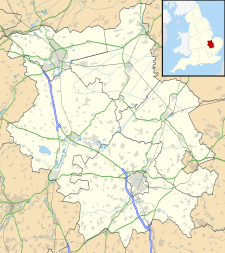
The Fens or Fenlands in eastern England are a naturally marshy region supporting a rich ecology and numerous species. Most of the fens were drained centuries ago, resulting in a flat, dry, low-lying agricultural region supported by a system of drainage channels and man-made rivers and automated pumping stations. There have been unintended consequences to this reclamation, as the land level has continued to sink and the dykes have been built higher to protect it from flooding.

Wisbech is a market town, inland port and civil parish in the Fenland district in Cambridgeshire, England. In 2011 it had a population of 31,573. The town lies in the far north-east of Cambridgeshire, bordering Norfolk and only 5 miles (8 km) south of Lincolnshire. The tidal River Nene running through the town is spanned by two road bridges. Wisbech is in the Isle of Ely and has been described as "the Capital of The Fens".
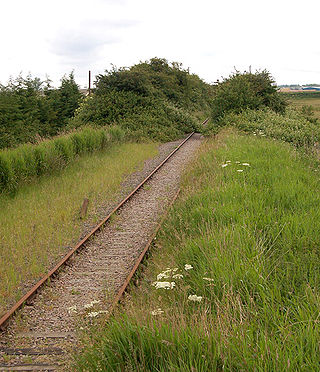
The Wisbech and March line is a railway line between March and Wisbech in Cambridgeshire, England. A number of proposals are currently being investigated relating to the possible restoration of passenger services along the route.

Peckover House & Garden is a National Trust property located in North Brink, Wisbech, Isle of Ely, Cambridgeshire, England.

Wisbech Grammar School is an 11–18 mixed, Church of England, private day school and sixth form in Wisbech, Isle of Ely, Cambridgeshire, England. Founded by the Guild of the Holy Trinity in 1379, it is one of the oldest schools in the country.
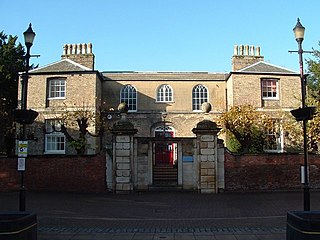
Wisbech Castle was a stone to motte-and-bailey castle built to fortify Wisbech on the orders of William I in 1072, it probably replaced an earlier timber and turf complex. The layout was probably oval in shape and size, on the line still marked by the Circus. The original design and layout is unknown. It was rebuilt in stone in 1087. The castle was reputedly destroyed in a flood in 1236. In the 15th century, repairs were becoming too much for the ageing structure, and a new building was started in 1478 under John Morton, Bishop of Ely. His successor, John Alcock, extended and completed the re-building and died in the Castle in 1500. Subsequent bishops also spent considerable sums on this new palace. The Bishop's Palace was built of brick with dressings of Ketton Stone, but its exact location is unknown.

Parson Drove is a fen village and civil parish in the Isle of Ely, Cambridgeshire, England. A linear settlement, it is 6 miles (10 km) west of Wisbech, the nearest town. The village is named after the central thoroughfare along which the village developed, a green drove, much wider than the current metalled road (B1166). The population at the 2001 Census was 1,030. The city of Peterborough is 19 miles (31 km) to the west, and the town of King's Lynn is 21 miles (34 km) to the east.

The Cambridgeshire Regiment was an infantry regiment of the British Army, and was part of the Territorial Army. Originating in units of rifle volunteers formed in 1860, the regiment served in the Second Anglo-Boer War and the First and Second World Wars before losing its separate identity in 1961. Its lineage is continued today by the Royal Anglian Regiment. The regiment and men are often referred to as the Fen Tigers.

Wisbech St Mary is a village in the Fenland District of Cambridgeshire, England. It is 2 miles (3 km) west of the town of Wisbech. It lies between two roads, the B1169 and the A47. The population of the civil parish at the 2011 Census was 3,556.
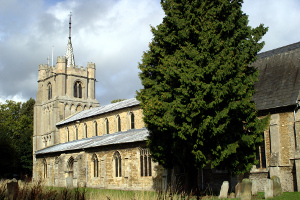
Elm is a village and civil parish in the Fenland District of Cambridgeshire, England. In Domesday, it is called Helle.

The Wisbech & Fenland Museum, located in the town of Wisbech in the Isle of Ely, Cambridgeshire, England, is one of the oldest purpose-built museums in the United Kingdom. The museum logo is W&F.

Walsoken is a settlement and civil parish in Norfolk, England, which is conjoined as a suburb at the northeast of the town of Wisbech, Isle of Ely, Cambridgeshire.

Gorefield is a village and civil parish in the Fenland district of Cambridgeshire, England.

Newton-in-the-Isle is a village and civil parish in the Fenland District of the Isle of Ely, Cambridgeshire, England, The village is 4 miles (6 km) to the north of Wisbech.
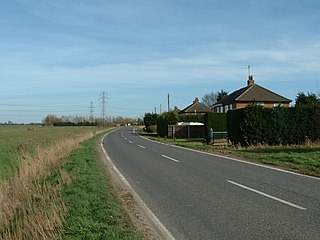
Tydd St Mary is a village and civil parish in the South Holland district of Lincolnshire, England, about 9 miles (14 km) east of the town of Spalding and about 5 miles (8.0 km) north of Wisbech, Cambridgeshire. The Civil Parish includes the village of Tydd Gote which lies partly in Tydd St Mary and partly in Tydd St Giles, Cambridgeshire.
Joseph Medworth a son of Simon Medworth (1723-1761), a ropemaker, and Anna Lampson was born in Wisbech in 1752. He was apprenticed as a brick-layer and moved to London. He returned as a successful developer and bought Thirloe's mansion.

Thorney Toll is a hamlet in Fenland District, in the Isle of Ely, Cambridgeshire, England. The hamlet sits either side of the A47 between Guyhirn and Peterborough. It is 12 miles from Wisbech. The population is included in the civil parish of Wisbech St Mary.
Samuel Smith was an English photographer.
Jane Stuart, was a Quaker who lived and died in Wisbech, England. There is a long-standing tradition that she was a natural daughter of James II of England.

The Crescent consists of rows of terraced houses and religious buildings laid out as a circus in the town of Wisbech, England. Initiated by the developer Joseph Medworth and built between 1794 and c1815, it is a rare examples of a Georgian circus to be found in the United Kingdom. Most properties have Grade I or Grade II listed building status. Although some changes have been made to the various sites over the years, much of the Georgian facade remains as it was when first built. This development now lies within the Wisbech Conservation Area.

